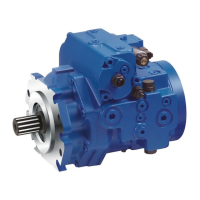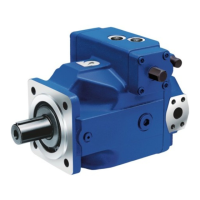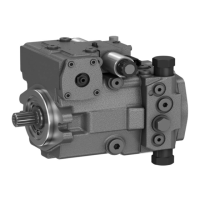About this product 21/64
RE92035-01-B/2019-11-25, A4VG Series35, Bosch Rexroth AG
5.2.2 Functional description
Torque and rotational speed are applied to the drive shaft (1) by a drive motor.
Thedrive shaft is connected to the cylinder(9) by splines, causing the cylinder to
rotate. With every revolution, the pistons (10) perform a stroke in the cylinder bores,
the sizeof which depends on the pitch of the cradle (12). The slipper pads(11) are
held on with the pistons and guided along the glide surface of the cradle by the
retaining plate(2).
The pitch of the swashplate during a revolution causes each piston to move over the
bottom and top dead centers and back to its initial position.
Hydraulic fluid is fed into and out through two control slots in the control plate(4)
according to displacement. On the high-pressure side (5), the hydraulic fluid is
pushed out of the cylinder chamber and into the hydraulic system by the pistons.
Atthe same time, hydraulic fluid flows into the growing piston chamber on the
low-pressure side (7). In a closed circuit, this is supported by the return flow and
boost pressure.
The two high-pressure relief valves protect the hydrostatic gear (pump and motor)
from overloading. They limit the maximum pressure in the respective high pressure
line and serve simultaneously as boost valves. High-pressure relief valves are not
working valves and are only suitable for pressure peaks or high rates of pressure
change.
The boost pump(6) continuously supplies a sufficient volume of fluid (boost volume)
from a small reservoir to the low-pressure side of the closed circuit via a check valve
to replenish the internal leakage of the variable pump and consumer. The boost pump
is an internal gear pump which is driven directly via the drive shaft.
In order to replenish the internal leakage in the variable pump and consumers, portG
must be connected to an external source of boost pressure. The boost-pressure relief
valve is integrated.
The swivel angle of the cradle (12) is infinitely variable. Adjusting the swivel angle
changes the piston stroke and, with it, the displacement. Moving the swashplate
across the neutral position will change the direction of flow (making reversing
operation possible). The swivel angle is controlled hydraulically by the stroking
piston(3). The cradle is mounted in swivel bearings for smooth operation and the
neutral position is spring-centered. Increasing the swivel angle increases the
displacement; reducing the angle reduces displacement accordingly.
Various control devices are available depending on requirements.
Informationabout this can be found in datasheet92035.
Pump function
High-pressure safeguarding
Version with boost pump
Version without boost
pump (external boost
pressure supply)
Control

